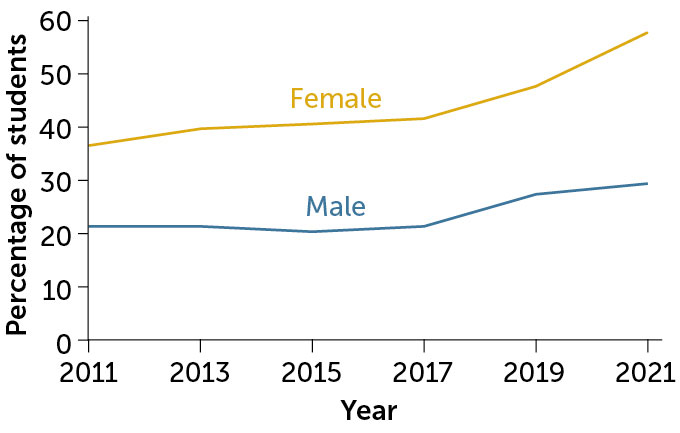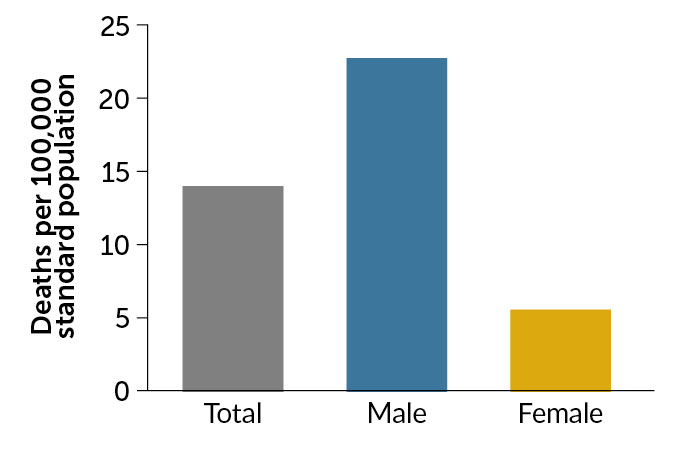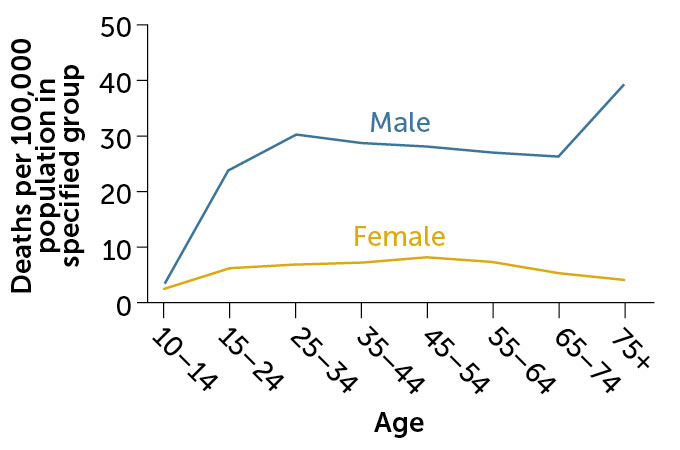
 Photo by Victoria Rain on Pexels.com
Photo by Victoria Rain on Pexels.comSurveys of #teen #mentalhealth may underestimate boys’ despair
By Sujata Gupta
#Teenagers in the #UnitedStates are in crisis. That news got hammered home earlier this year following the release of a nationally representative survey showing that over half of #highschool #girls reported persistent feelings of “sadness or #hopelessness” — common words used to screen for #depression. Almost a third of #teenage #boys reported those same feelings.
“No one is doing well,” says #psychologist Kathleen Ethier. She heads the U.S. #CentersforDiseaseControlandPrevention’s Division of #Adolescent and #School Health, which has overseen this biennial #Youth Risk #Behavior Survey since 1991.
During the latest round of data collection, in fall 2021, over 17,000 #students from 31 states responded to roughly 100 questions related to #mentalhealth, #suicidalthoughts and #behaviors, #sexualbehavior, #substanceuse and experiences of violence.
One chart in particular garnered considerable media attention. From 2011 to 2021, persistent sadness or #hopelessness in #boys went up 8 percentage points, from 21 to 29 percent. In #girls, it rose a whopping 21 percentage points, from 36 to 57 percent.
Some of that disparity may arise from the fact that #girls in the #UnitedStates face unique stressors, researchers say. Compared with #boys, #girls seem more prone to experiencing #mentaldistress from #socialmedia use, are more likely to experience #sexualviolence and are dealing with a political climate that is often hostile to women’s rights (SN: 7/16/22 & 7/30/22, p. 6).
But the gap between #boys and #girls might not be as wide as the numbers indicate. #Depression manifests differently in #boys and #men than in #girls and #women, mounting evidence suggests. #Girls are more likely to internalize feelings, while #boys are more likely to externalize them. Rather than crying when feeling down, for instance, #boys may act irritated or lash out. Or they may engage in risky, impulsive or even violent acts. Inward-directed terms like “sadness” and “#hopelessness” miss those more typically #male tendencies. And masculine norms that equate sadness with weakness may make #males who are experiencing those emotions less willing to admit it, even on an anonymous survey.
Consequently, screening tools, such as the one used by the #CDC’s survey, may miss #depression in about 1 in 10 #males, research suggests.
“We need to have more of a recognition that #boys and #men, some of them, not all of them, are suffering,” says clinical #psychologist Ryon McDermott of the University of South Alabama in Mobile. “And we miss them. We miss them in our assessments, and we miss them in our discussions.”
Diagnosing #depression in #boys and #men
The idea of overlooked #depression in #men is not new. Take what happened on the Swedish island of Gotland. In the 1960s and ’70s, #suiciderates were high. So in 1983, health officials launched an education program for Gotland #doctors on #depression treatment and #suicideprevention.
At first, the program looked like a resounding success. The island’s overall #suiciderate dropped from roughly 20 out of every 100,000 people in 1982 to roughly 7 out of every 100,000 people by 1985, researchers reported in the 1992 Acta Psychiatrica Scandinavica.
But a subsequent, deeper analysis showed that the decline was almost entirely among #women. In the 2½ years before and after the program, the number of #women dying by #suicide decreased from 11 to two, while the number of #men dying by #suicide mostly stayed steady, seeing a marginal decline from 16 to 15.
#Men struggling with #suicidalthoughts appear less likely to seek help and more likely to have #doctors ignore their depressive symptoms when they do seek help, Wolfgang Rutz, then a #psychiatrist at a Gotland hospital, theorized in 1996 in the Nordic Journal of Psychiatry. #Doctors observed, for instance, that #men who were depressed often didn’t present with classic symptoms, such as sadness, but instead presented as hostile, impulsive and aggressive.
Rutz suspected that this #gender disparity in diagnosis and treatment might underpin why, at the time, #men in Sweden were being diagnosed with #depression half as often as #women but dying by #suicide five times as often. Without obvious signs of #depression, Rutz noted, to the outside observer, many #male #suicides occurred seemingly without warning.
“The criteria of #depression that are taught in psychiatric textbooks and diagnostic manuals today and which also have been used in the Gotland project seem insufficient in detecting the typical masculine way of being depressive,” Rutz wrote.
Rutz went on to develop a screening tool for #male #depression, which paved the way for more recent male-specific tools. They include the #Male #Depression Risk Scale, developed by Simon Rice, a clinical #psychologist at Orygen, an Australian nonprofit research, clinical and advocacy institute focused on youth #mentalhealth.
The scale focuses on emotion suppression, anger and aggression; #drug and #alcohol use; somatic symptoms, such as concerns about sleep and sex; and risk-taking. Participants rate various statements, such as how often they bottle up negative feelings, have difficulty managing anger or use #drugs for temporary relief. None of the questions ask about sadness or #hopelessness.
Better screening
The #Male #Depression Risk Scale asks individuals to rate how often over the last month various statements (some shown below) apply to them.
- I bottled up my negative feelings.
- I had unexplained aches and pains.
- I needed #alcohol to help me unwind.
- I overreacted to situations with aggressive #behavior.
- I stopped caring about the consequences of my actions.
- It was difficult to manage my anger.
- Using #drugs provided temporary relief.
Research shows that some #men meet the criteria for #depression on the #Male #Depression Risk Scale but not on more traditional scales. In a recent study of 1,000 Canadian #men, Rice and his team found that 80 respondents, or 8 percent, met the criteria for #depression only on a traditional scale that includes a question about how often the respondent has felt “down, depressed or hopeless.” In addition, 120 respondents, or 12 percent, met the criteria on both scales. But 110 respondents, or 11 percent, met the criteria for #depression only on the men’s scale, the team reported in 2020 in the Journal of #MentalHealth.
The results suggest that had the #CDC’s #Youth Risk #Behavior Survey included a #male-specific question about #depression, there might still have been a #gender gap but perhaps a smaller one.
Too many #boys and #men are suffering in silence, says Rice, who is also a principal research fellow at the University of Melbourne. Ten or 11 percent of missed cases “might sound like a small percentage,” he says, “but at the population level, that is huge.”
Is it #depression or something else?
The idea that acting out and aggression could, on occasion, constitute symptoms of #depression remains controversial.
The #CDC, Ethier says, has relied on extensive research in formulating its survey’s #depression-related question, which reads: “During the past 12 months, did you ever feel so sad or hopeless almost every day for two weeks or more in a row that you stopped doing some usual activities?”
“That item is actually quite good at predicting who has depressive symptoms,” Ethier says, adding that such accuracy holds true for both #girls and #boys.
That’s not to say that #boys aren’t struggling, Ethier says. Anecdotally, for instance, #teachers are reporting a spike in #behavioral problems in their classrooms, particularly among #boys. But rather than indicating #depression, Ethier says, such #behavior is emblematic of the broader #mentalhealthcrisis among #teens.
That might sound like splitting hairs. If #boys are distressed, why not label them as depressed? Providing the proper diagnosis matters for appropriate treatment and future health outcomes, Ethier says. “We know that depressive symptoms in #adolescence have long-term implications for health and #mentalhealth. I don’t know that the research is as conclusive about that for #behavioralissues in the classroom.”
For McDermott, who studies the difficulties of measuring #depression, such #behavioral problems could indicate other disorders, chiefly #attentiondeficithyperactivitydisorder. But he has no doubt that some of those #boys are depressed. “It is hard to say with 100 percent certainty that all #boys who are acting out are experiencing #depression, but it is a good bet that many of them are,” he says.
Depths of despair
Over the last decade, a national survey of U.S. #highschoolstudents called the #Youth Risk #Behavior Survey has consistently found higher levels of persistent feelings of sadness or #hopelessness in #teen #girls compared with #teen #boys. But some experts say the survey may not offer a complete picture of boys’ #mentalhealth.
Percentage of #highschoolstudents reporting persistent feelings of sadness or #hopelessness
 C. CHANG
C. CHANGThe core symptoms of #depression, whether internal or external in nature, are the same in #men and #women, McDermott says. But on a #depression scale focusing on internalizing symptoms such as sadness or #hopelessness, a depressed man would, on average, score lower than an equally depressed #woman.
Why those baselines vary by #gender isn’t entirely clear, McDermott says. But when it comes to #hopelessness, evidence suggests that #boys might sometimes suppress those feelings in adherence to #male norms that discourage vulnerability. Consider the results of a review of 74 studies with a total sample size of more than 19,000 mostly U.S. participants published in 2017 in the Journal of Counseling Psychology. High scores on a scale measuring conformity to Western masculine norms, such as emotional control, self-reliance and power over #women, were linked with poorer #mentalhealth, including #depression, and a reduced likelihood of seeking help.
Gender norms become entrenched during the #teen years, says Leslie Adams, a #behavioral researcher at Johns Hopkins University. That’s when #boys are really absorbing messages around masculinity from friends, family and #socialmedia. “Endorsing feelings of sadness and #hopelessness kind of goes against these learned, general scripts,” Adams says.
Those #male scripts are poorly understood, say Adams and others studying #male #mentalhealth, because most #gender research focuses on #girls and #women.
For instance, take research into #socialmedia use. Ethier points to the popularity of #male #socialmedia personalities espousing harmful attitudes toward #women, such as TikToker Andrew Tate, who was recently arrested in Romania on suspicion of human trafficking. Anecdotally, Tate and influencers like him are one way #boys come to understand the world, but data on the influence of #socialmedia on #boys are sparse, Ethier says.
“We focus a lot on the ways that #socialmedia might be impacting #girls in terms of body image,” she says. “I don’t think we focus enough of the conversation on what is being portrayed to #boys.”
The resulting knowledge gap about #boys’ lives affects all of society. “It is difficult to see that we can effectively address the health of #boys and young #men, achieve gender equity for #girls and young #women, or achieve rights for #lesbian, #gay, #bisexual and #transgender #youth, without tackling the masculine identities adopted by #boys in #adolescence,” a group of pediatric health experts wrote in a commentary in 2018 in the Journal of #Adolescent Health.
#Depression’s link to #suicide
Just as Rutz observed on the island of Gotland, missing #depression in #boys and #men can come with high stakes.
“#Depression can manifest in many ways … beyond sadness and #hopelessness,” Adams says. “When we don’t assess the other ways that #depression can manifest, there are implications. One is #suicide.”
Adams suspects that the same tendency to frame #depression as an internal emotion also influences how researchers ask about #suicide. For instance, asking about who has considered #suicide or made a plan, as the #CDC does in its #youth survey, reflects the belief that the respondent is both ruminating and thinking ahead. “For #boys, may not have that linear path,” Adams says. “We’re missing … impulsivity.”
That could help explain why, in the #CDC survey, #teen #girls reported higher levels of suicidal thinking, planning and attempts than #boys, despite the fact that #boys die by #suicide at higher rates. Provisional federal data show that, in 2021, roughly 6 of every 100,000 girls ages 15 to 24 died by #suicide. That’s compared with roughly 24 of every 100,000 #boys of the same age. From 2020 to 2021, the rate of #suicide in that age group increased 5 percent in #girls compared with 8 percent in #boys.
#James Donaldson notes:
Welcome to the “next chapter” of my life… being a voice and an advocate for #mentalhealthawarenessandsuicideprevention, especially pertaining to our younger generation of students and student-athletes.
Getting men to speak up and reach out for help and assistance is one of my passions. Us men need to not suffer in silence or drown our sorrows in alcohol, hang out at bars and strip joints, or get involved with drug use.
Having gone through a recent bout of #depression and #suicidalthoughts myself, I realize now, that I can make a huge difference in the lives of so many by sharing my story, and by sharing various resources I come across as I work in this space. #http://bit.ly/JamesMentalHealthArticle
Find out more about the work I do on my 501c3 non-profit foundation
website www.yourgiftoflife.org Order your copy of James Donaldson's latest book,
#CelebratingYourGiftofLife: From The Verge of Suicide to a Life of Purpose and Joy

www.celebratingyourgiftoflife.com
#Suicide stats
The latest data in the #UnitedStates show that the overall #suiciderate for #males is much higher than for #females. That gap holds across most age groups, even though #teen #girls report higher levels of suicidal thinking and planning than #boys.
U.S. age-adjusted #suiciderates in 2021

#Male and #female #suiciderates in 2021, by age

SOURCE: NATIONAL CENTER FOR HEALTH STATISTICS
CREDIT: C. CHANG
Access to guns might factor in here. For every 10 percent increase in household gun ownership in a state, the #youth #suiciderate increases by about 27 percent, researchers reported in 2019 in the American Journal of Preventive Medicine. And #boys are seven times as likely to kill themselves with a gun than #girls are, according to a 2022 report by Everytown for Gun Safety, a #gunviolence prevention organization.
Missed #depression in #boys could help explain a long-standing research question, Adams and others say: Why do more women get diagnosed with #depression, the most common precursor to #suicide, when more #men die by #suicide?
One path forward is to look beyond sadness and #hopelessness as proxies for #depression, Adams says. What about impulsivity, conflict with others or social withdrawal? Perhaps those symptoms serve as better proxies for #depression — and suicidal thinking — in #men, she says.
Understanding other proxies could protect not just depressed individuals from harm but also broader society, another line of research suggests. Seena Fazel, a forensic #psychiatrist at the University of Oxford, and colleagues began examining data from Swedish #patient registries to investigate if #depression links to violent #behavior. Their participant pool included about 47,000 #adults diagnosed with #depression from 2001 to 2009 and nearly 900,000 people without such a diagnosis.
People with #depression were three times as likely to commit a violent crime, such as assault, arson or a sexual offense, as individuals without depression, the team reported in 2015 in Lancet Psychiatry.
To attempt to rule out genetic or environmental differences, the team looked at siblings. A person with #depression was twice as likely to commit a violent crime as their sibling without #depression. Fazel and another team reported a similar link between #depression and violence among #teens and young #adults in 2017 in the Journal of the American Academy of #Child & #Adolescent Psychiatry.
https://standingabovethecrowd.com/2023/07/jamesdonaldson-on-mentalhealth-boys-experience-depression-differently-than-girls-heres-why-that-matters/


No comments:
Post a Comment